Submitted by eyolf on
Listening to Dylan never gets better than during the moments when one senses that he and his band are engaging in some kind of exploration on stage – where a small melodic figure is exposed to any kind of treatment imaginable. This is a style that has been used consistently during the Never-Ending Tour years, and it may have to do with the ‘Lonnie Johnson’ method. This chapter may therefore be seen as a more practical application, to concrete music, of the more theoretically oriented points discussed in the previous chapter.
Three performances in particular stand out as examples. As it happens, they are all live versions of the same song – Mr Tambourine Man. The first is from Drammenshallen, Norway, 10 June 1981, the second from Cascais, Portugal, 13 July 1993, and the third from Vienna, Austria, 30 April 1999.
Is this a coincidence, that they are all Tambourine Men? Perhaps not: as I intend to show, there are some musical traits in this song that may have opened up the possibilities that he explores in these performances.
Preamble: The Song – A carnival in sound
Most songs begin with the key note, also called the tonic. A song in C major begins with a C major chord, etc. Usually some kind of dynamics are created by moving to other tonal areas – the dominant and the subdominant.
Put simply, this means that there is a contrast between two tonal areas: a level of rest, represented by the keynote, and a contrasting level, represented by the dominant, the tone a fifth above the keynote.
The fifth is the stable, loyal companion to the keynote, always there, not without its conflicts, but they are always resolved, and always in favour of the tonic – somewhat like a good old (or perhaps rather: bad old) patriarchal marriage. In fact, one might consider all music within the Western musical tradition (until the late nineteenth century in the art-music tradition, and until this day in the popular traditions) as nothing more than a play with the balance between these two scale steps.
But then there is the third important chord in the basic three-chord pattern: the subdominant. It usually stands a little behind the other two in the line-up – doesn’t have the self-conscious power of the tonic, nor the rebellious subservience of the dominant – but in Mr Tambourine Man, it’s the real protagonist.
The subdominant has a double role. Partly it is a chord closely related to the tonic, in many cases hardly more than a variant of it. This is most clearly seen in the standard blues embellishment:

In this capacity, it functions as a reinforcement of the tonic. But it also has a more expansive role, as the first step away from the tonic, especially in combination with the dominant, in some kind of cadential progression. The mother of all such cadences, at least in text books, is T-S-D-T (the beginning of Blowin’ in the Wind is an example). The dominant creates a tension, which demands a resolution back to the tonic, and the subdominant is a helper on the way to get there, roughly speaking.
What is special about Mr Tambourine Man is that it does not begin on the keynote, but on the subdominant, from where it returns to the Tonic by way of the Dominant (S-D-T). In other words: the song begins in the middle of the cycle of tension and resolution that the cadential progression is, but without ever establishing, or even hinting at, a level of resolution first. Instead, Mr Tambourine Man starts on the second step of the T-S-D-T cycle. One might say that the song doesn’t have a real beginning: musically speaking, it has already started before we hear the first sounds, since the Subdominant implies that something has preceded it.
The chord on ‘…(song for) me’ is again a Subdominant, and in a way we have come full circle – only it is the wrong circle. (S-D-T-S, instead of the ‘correct’ T-S-D-T).
After the initial burst, the Tonic that we were cheated of in the beginning is now finally established. – Or is it? The next phrase, ‘I’m not sleepy and there is no place I’m going to’, brings another fragment of the standard cadential cycle. This time it’s the beginning: T-S-D. In the traditional form of the progression, this gesture functions as the build-up phase in the cycle, where the Dominant proves its ‘proper’ function as the disruptive force, demanding – and getting – a resolution back to the Tonic again. Here, it works the opposite way: this is how all the mid-verses, the full verses, and the mid-refrains end, after shorter or longer stretches of uncertainty, so in the course of the song, it is as if the Dominant and not the Tonic behaves as the point of repose, where some kind of resolution is reached.
Concerning the refrains, the exposition above can be summarized in the schematical overview:
S D T S || T S D . | S D T S || T S D T |
First an ‘upside down’ cadence going the wrong full circle (S-D-T-S instead of T-S-D-T), then a ‘reversed’ cadence resting on the unstable D step; this is then repeated, and we finally, finally get the resolution in the very last line of the refrains.
And the verses? They can be found in the intersection between the two ‘wrong’ cadence gestures:
__________
| |
S D T S || T S D .
The first ends with T S, the second begins with it. The chords are the same, but the function is different: first an uneasy coming to rest on the wrong step, next the start of a new beginning.
What happens in the verses is not so much that the T S || T S part is repeated, as that the two halves merge into one little T S segment, which is repeated ad libitum. So the verses look like this:
S D ||: T S :|| D .
The difference is subtle but important: This segment becomes a single unit, which retains the character of both its former incarnations at the same time; it is impossible to decide whether the chords to the line ‘the haunted frightened trees’ in the last stanza are an end or a beginning: they are both (and therefore, perhaps, neither).
All in all we might say that in the musical narrative of Mr Tambourine Man everything is backwards and upside down (as an equivalent to the textual narrative of All Along the Watchtower). Every character plays someone else’s role. It’s a musical carnival …
First Man: Drammenshallen, 1981
Memories … This was the first concert I didn’t see. It was the first, because I could have been there, but I wasn’t – because I had no idea it took place. I was fourteen and also had no idea that Dylan had sent shock waves through the musical world by converting to Christianity. I don’t remember exactly, but I like to imagine that while Dylan was playing his first show on Norwegian ground, I was playing football on my grandparents’ lawn, spitting distance from Drammen.
But it is also another ‘first’: it was the tape with which I lost my tape-collector’s virginity. A kind soul (thanks, Karl-Erik!) had allowed me to pick five tapes from his list. I had no idea what it would sound like – concert tapes? could I expect to hear anything at all, apart from screeches and scratches? I had no idea – but I knew I had crossed a line. I was no longer a casual listener with a soft spot for Dylan – I was a dedicated fan and a tape collector. I had made an effort to seek out secret material. I had entered the circle of people who had access to this material. I had become a member of a secret brotherhood. If the tapes sounded like crap, this would in fact make me an even more dedicated fan.
Drammenshallen 1981 was the first tape I put on. Out into my kitchen flowed The Times They Are A-Changin’ in the most fantastic arrangement I had ever heard, and the rest of the show seemed just as brilliant.
I don’t know if it was the thrill of the first-time experience, but to this day, many of the songs from this concert are among my all-time favorite versions: Just Like a Woman, Girl from the North Country, The Times They Are A-Changin’ – and then there was the Tambourine Man…
It begins innocently enough:
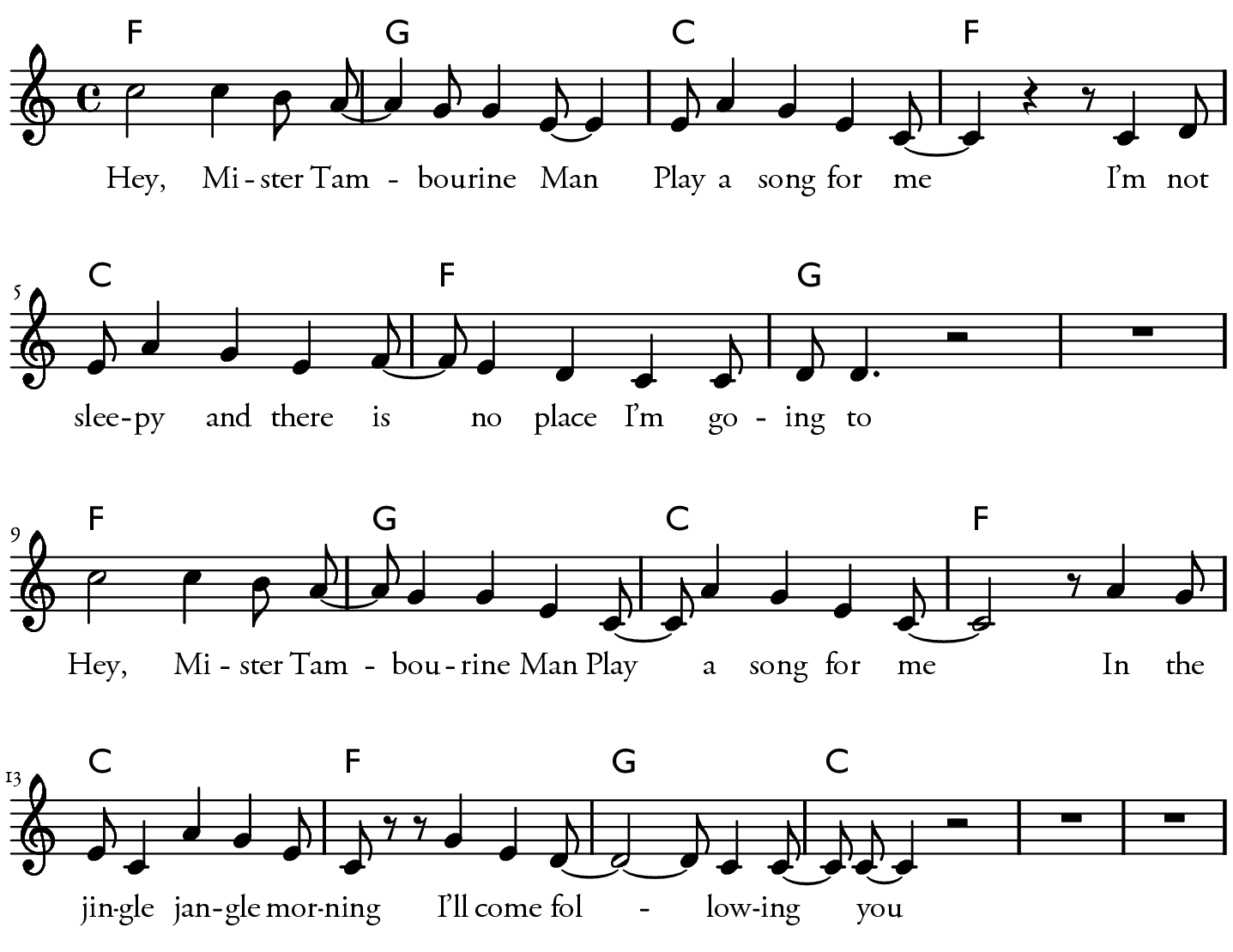
So much so that it took me a couple of listenings to even notice this song among the other gems on the tape. The intro and the beginning of the singing sounds nothing out of the ordinary – closer to the saccharine Budokan than to the desperate Charlotte version from December 1978, which is a fierce contender for the #1 spot on my list.
These are the elements he plays around with: (a) a displacement of the rhythm, either in a simple, basic syncopation (| |) or a looser phrasing, involving some kind of triplet feeling that is mostly impossible to fix in notation; (b) a reduction of the melody to a handful of tones and figures; and (c) the lyrics sung to these fixed, syncopated figures, without any regard for the actual rhythm of the text.But it grows. The end of the first chorus is a foreboding of things to come: the audience doesn’t know it, Dylan himself doesn’t know it yet, but the final measures contain in nuce everything that is needed for what over the next couple of minutes will become a remarkable, memorable, performance.
In the first verse, it is one figure and one figure only that rules.
Bildetekst
The line c a g f e recurs again and again, and the tones a and e are elevated from their anonymous positions in the original melody, to become the constantly recurring start- and end-points in an endless series of repetitions.
In the second verse, the melody is raised from its position around the bottom end of the ambitus around the lower c, to the c an octave higher.
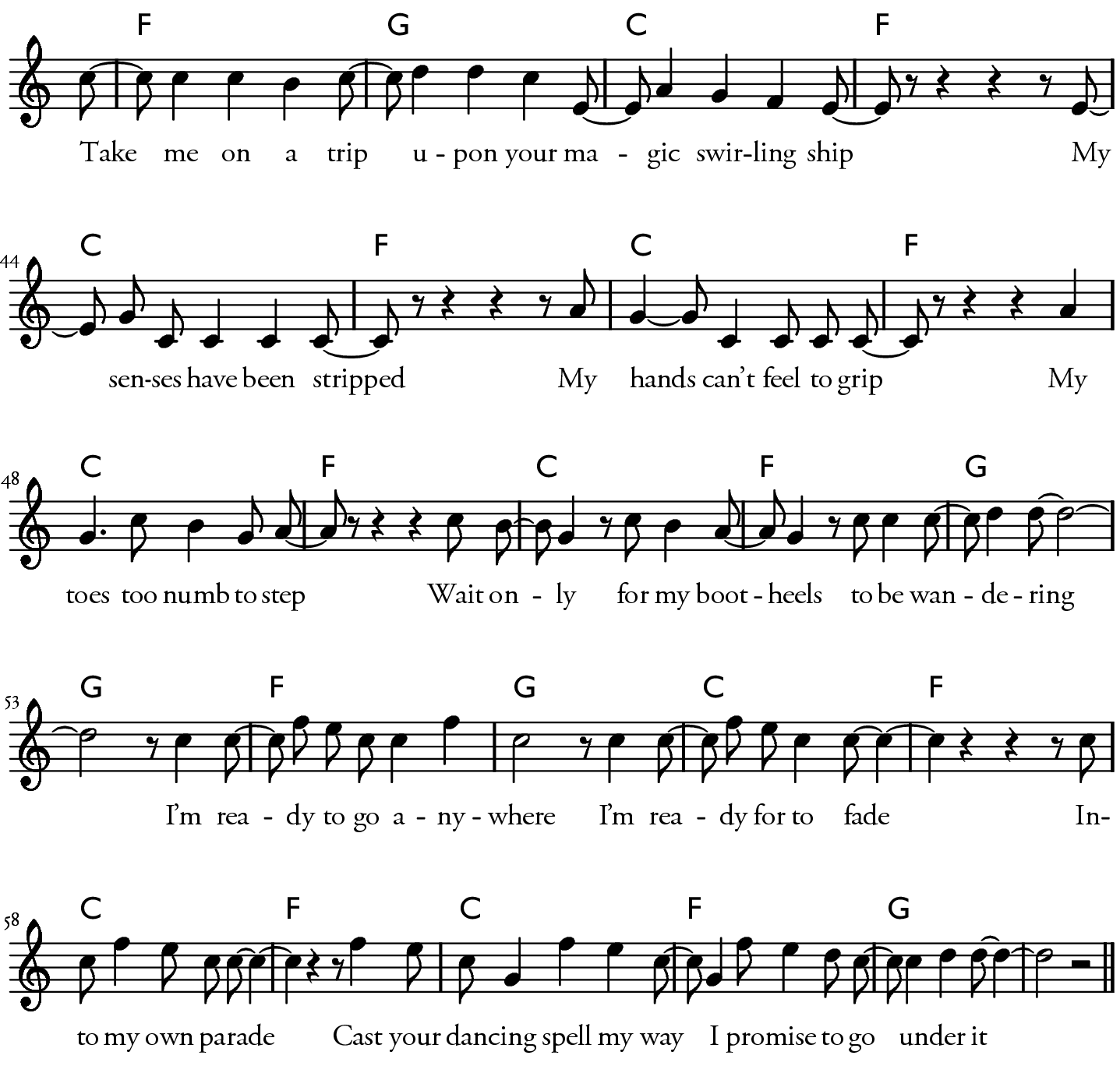
The tones a and e gradually lose their freshly acquired status. Their place is taken by f, c, and g. These also happen to be the key-notes of the chords F, C and G, but that does not mean that the melody now conforms with the harmonic outline of the song and that no harmonic tension is left. On the contrary: these tones occur where the logic of the motivic repetition decrees – not where the harmony might suggest.
Lastly, the span of melodic movement widens, in frequent, restless skips (e.g. at ‘Cast your dancing spell my way’).
The last verse continues the rumination over the three tones c, f, and g. The rhythm becomes looser and looser, wilder and wilder, more and more engaged, mostly rushed, but once in a while pausing, as if to give the band a chance to catch up (or perhaps to allow the singer a chance to come up for air).
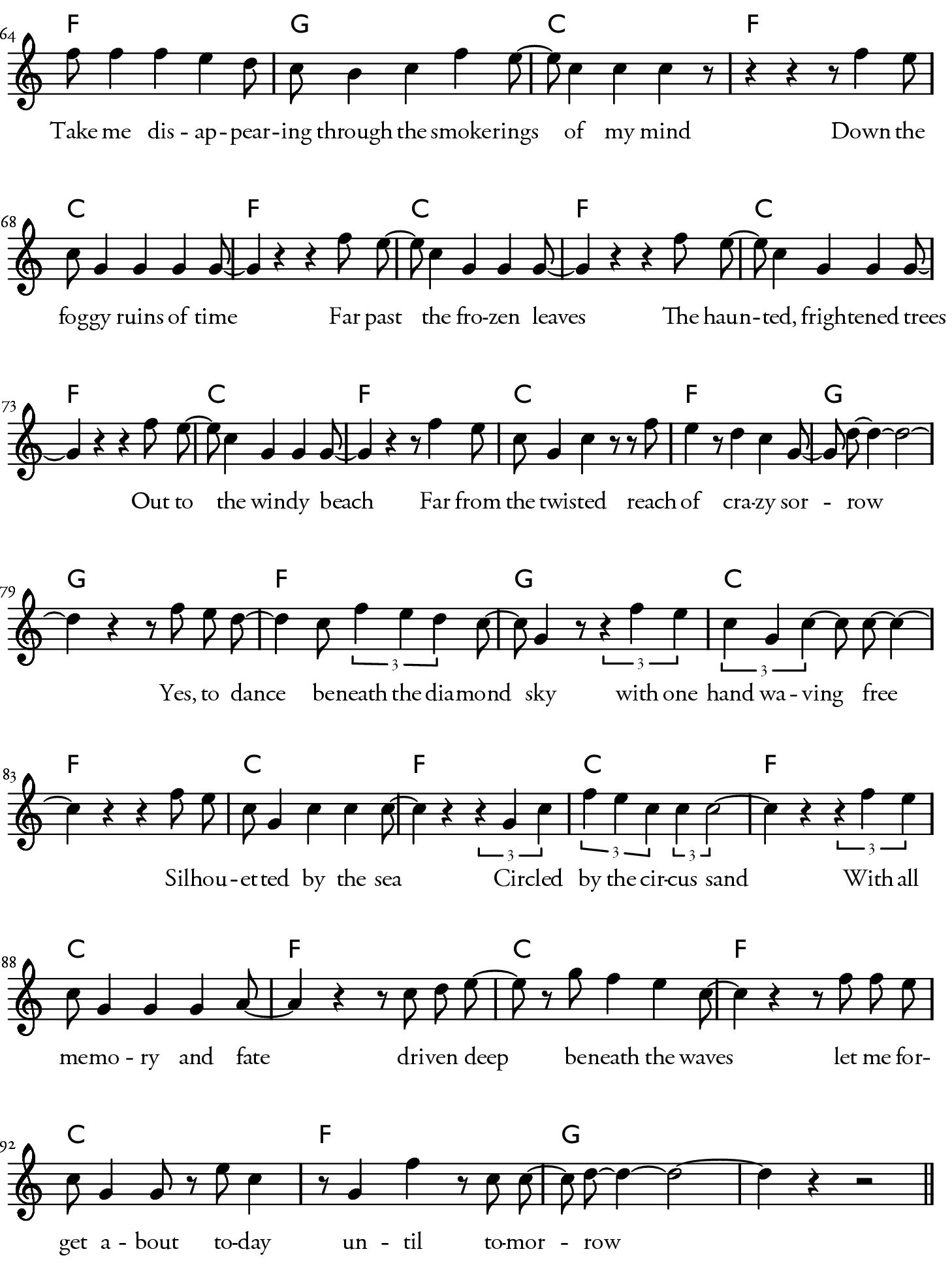
The elements that make up the logic of the Drammen Tambourine Man come together in a particularly successful union on this night and in this song. But they are recognizable in other songs and on other nights during the same tour. The reggae-ish syncopated looseness of phrasing is prominent during the entire 1981 tour (an obvious example from the same concert is Knockin’ on Heaven’s door, to which the audience responds with an embarrassing display of ‘stadium clapping’, to which Dylan mysteriously replies: ‘You people got rhythm. You got more rhythm than they got back in Texas’ – either an insult to the Texans, or a subtly ironic comment).A new logic is created, a musical logic that only applies here, during these five minutes, but that is indisputable while it goes on. Towards the end of the verse, this logic has become so integrated in the performance and the listener’s perception of it that it comes as a great surprise when a new inflection is suddenly introduced. The direction of motion is reversed from the predominant downward churning, to a rising figure, which also touches the highest tone in the entire song, a high g. Coincidentally, this happens to the lines ‘With all memory and fate | driven deep beneath the waves’, which thus becomes the emotional climax of the song.
First conclusions and suggestions
What is it then, that makes this particular performance stand out? It is hard to tell – it could be that Dylan is particularly inspired, but what is that? What is it that he’s doing, that either brings about this inspiration (which doesn’t seem to be there in any particular degree when the song begins) or brings it through?
In Performing Artist, Paul Williams quotes Christopher Ricks’ reaction to this version:
Dylan alters his inflection throughout, his voice rising on a word or phrase where we would expect it to fall, an vice versa. The effect is to invite and require us to experience the song as something new (our old sense of its language has been annulled, destroyed).
I like the description. It is only natural that a literary scholar like Ricks would emphasize the sense of the song’s language. I, as a musical scholar, would much rather point out the musical work as the decisive playground here.
Tentatively, I’d like to point out three possible factors.
First of all, the phrasing – the interplay between the singing and the text – is in compliance with general rules for generating musical interest, not least the interest that is generated in the area where text and music meet, where the sonorous aspects of text (such as rhythm, stress, vowel quality, speed) become a matter of musical interest – an area that has always been at the centre of Dylan’s creative output. [Cf. the final discussion in ‘Beauty May Only Turn to Rust’] This is, I believe, the fundamental precondition for the performance to work: Dylan makes the text talk in a different way than usual – and than usual talk – by manipulating those elements other than the literary meaning that words consist of, through a rigorous musical logic.
And this logic is the second factor: the performance of Mr Tambourine Man from Drammen can fruitfully be regarded as an example of the ‘Lonnie method’, seven years before it was – according to Dylan in Chronicles – turned into a conscious method. Even though most or all of the elements in the performance are recognizable from other performances, they are combined more consistently here than elsewhere, and in stronger accordance with the Lonnie-principles.
And thirdly, the motif that he chooses or finds is strong enough to establish this additional level of (musical) meaning, and it is strong enough to carry the interest of the listeners (including the one most actively involved: the performer himself).
Take away any of these elements – and you may still have a decent performance. But the combination…
Second Man: Cascais, 1993
The second Tambourine Man is a wonderful example of the ‘Lonnie’-style applied to playing instead of singing: Cascais, Portugal, 13 July 1993. The 1993 tour is notorious for its long solos, causing ordinary songs to clock in at well over ten minutes. This is no exception.
The Lonnie hat comes on during the first solo section, c. 3:17 into the song. The setting for this solo is not choruses and verses, but the circling around Tonic and Subdominant that makes up most of the verses (see p. ![[*]](file:///home/eyolf/dokumenter/tekster/om-dylan/thingsTwice/latex/tmen/crossref.png) above). This is extended indefinitely – or to be more precise: the sequence D G/d, is played 82 times during the solo.
above). This is extended indefinitely – or to be more precise: the sequence D G/d, is played 82 times during the solo.
After the first nine repetitions, the solo itself begins. In the beginning, it is far from remarkable. Dylan doodles around with a couple of tones, and some of them clearly sound like errors – all in all, one of those two-string things that on a bad day can become slightly vexing.
This isn’t one of those days.
Throughout the entire solo – two and a half minutes – six tones are played, in two groups: an upper cluster of f, g, and a (and an occasional f#), and a lower with c, c#, and d. That’s all. These tones are played around with, in a way that resembles how an Indian sitar player presents the tones in the raga he has chosen.
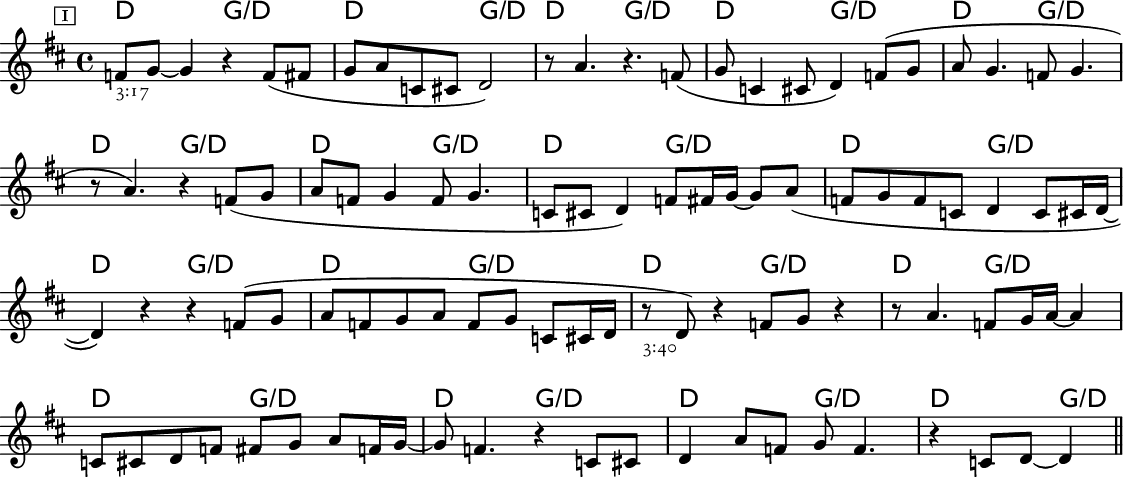
Gradually, the tones find more fixed places, and the doodle morphs into a little motif (at 3:52):

This is repeated a couple of times, then cut up and stretched out:
And then: the whole thing is played again, but started one beat earlier (at 4:12):

After 4:32, the thing is played in yet another position:

These are the main variations that are used; repeated over and over again, with slight variations – most prominent of which is the reduction of the motif to the gesture a f . . | a g . . which lends it an uncompromising insistency:
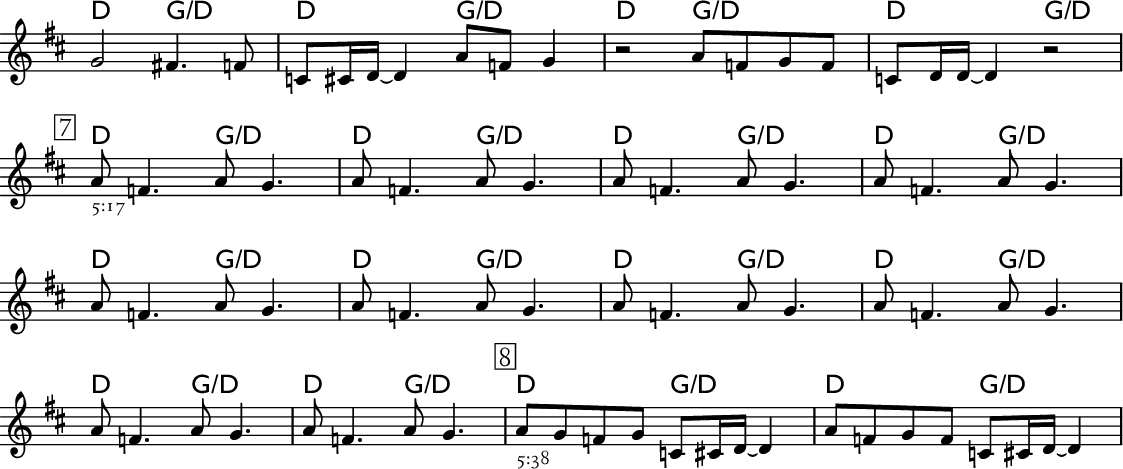
In general, the selection of melody tones in the solo includes c and f, both of which clash with the c# and f# of the key (D major). In addition, the motif also contains the key notes of the two chords D and G, but they appear in different positions in relation to the underlying chords in the three different variants.The shifting of the motif to three different position in the bar looks innocent enough on paper, but when heard, the character of the motif changes completely from one version to the next, because of the way different tones are emphasised in the interplay between the motif and the underlying chord structure. [“Completely” is an exaggeration, made with the best intentions: to make the effect of the system stand out as clearly as possible, as something truly striking. A more appropriate word would be ‘subtly’.] In the first variant (at 3:52), the tone g is concealed, as a mere auxiliary tone to the f/f# in the D chord, and when the chord G/d is reached, the melody strikes a d. Thus, in the sections that use the first variant, D is the dominating sonority. [Instead, the tone c gets a certain emphasis, so much so that an imagined harmonization of those passages might be D . C/d | G/d.]
In the second variant (at 4:12), it is the other way around: the tone g falls within the G chord block, and these two aspects of G-ishness reinforce each other mutually and emphasize the G sonority. Furthermore, the additional tones at the beginning of the motif, a and f, give the G chord a character of G9, which strengthens the G chord’s proper character even more. The D chord, on the other hand, is dominated by the tone c, which gives the chord a D7ish quality, which leads away from D and over to G.
The third variant (at 4:32) is the most neutral of the three. If anything, the c in the melody gives the G step a touch of Gsus4, which suggests the implied harmonization: D … | Gsus4 . G . – far from dramatic, compared to the other two. Which is not necessary: the effect of shifting the motif is more than enough.
The solo as a whole is a text-book illustration of the method Dylan describes in Chronicles: pick some tones, repeat them, make some changes, and the effect will inevitably come, no matter what.
This is also to say that the analysis above is not a suggestion as to what Dylan might have thought while he was standing there, on stage in Portugal, playing some notes over and over again. He was not thinking: ‘if I start this motif one beat earlier, this will emphasize the ambiguity between beginning and ending in the alternation between Tonic and Subdominant’ – on the contrary: he was just doing it, and the effect came afterwards.
A Nose
After the solo follows a verse (‘Take me disapperaring …’) which is sung with a fire that I hear as inspired by the successful solo. But then comes the real stroke of genius: In the middle of the following refrain, where the music halts on the Dominant chord A, what does Dylan play if not that little bugger of a motif, again!

Not a single tone is ‘right’, but the effect is glorious. The motif was devised to work in the environment between Tonic and Subdominant, where it, in a mixture of serendipity and musicality, subtly brought out different aspects of this environment.
Now we’re on the Dominant, and and every one of the tones that have been in play the first time around – g, d, c, f – clashes violently with the sustained A chord. But by throwing in the motif like this Dylan proves two things: first, that he is a true cubist: the motif works like a Picassian nose-from-all-sides-at-once, a synthesis of all the possibilities inherent in the song, in the motif, in the combination of the two, in the interplay within the band (I haven’t yet mentioned that Bucky Baxter also picks up on the motif after a while), in the Portugese summer night – and secondly, with this little flick of the wrist he also proves that everything is possible.
One last time we get to hear our little friend the motif, towards the end of the song (at 8:22). This time we’re back in the Tonic area again, and it’s like the afterglow of an orgasm. Hence, there is not much to say about it. [There is, however, more to say about the performance, such as the final harp solo, where the tempo slows down to a majestic pavane and the chords change – again! – to finally give the Dominant the prominence it requires but has so far been denied. Then again: perhaps the time has come to stop talking and succumb to the power of sound, which words can only mimic.]
The Third Man: Vienna, 1999
My third example of a successful use of the Lonnie method is the Tambourine Man from Vienna, April 30, 1999. It is not as striking as the Cascais experience, but it is interesting because it is a vocal example, because of the interplay between instruments and voice, and because of the ways the song was sung before and after this night.
Again, it is a very simple figure, a selection of some tones from the scale, that is in the centre of attention. In this case, it’s not just ‘some’ tones – it’s the entire scale.
It turns up for the first time at the end of the first refrain:

At the end of the first verse, we see two other elements being combined with the downward scalar rush: first, the phrase starts on a different tone, and second, the contraction of the whole phrase in a rapid succession of eight-notes, with complete disregard for any inherent phrasing in the melody or any textual rhythm:

In the second refrain, the motif comes into full bloom in several downward rushes, this time from the high e and down an entire octave or more, first to the d below and later yet another half octave down to b:
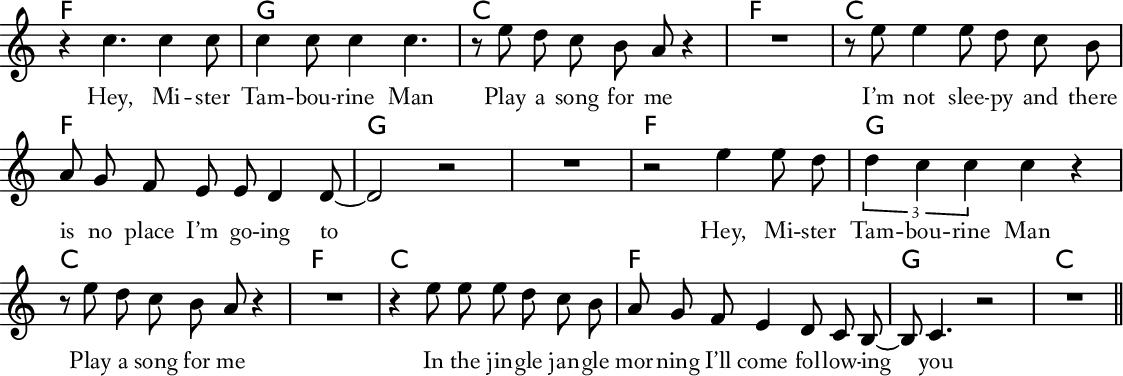
As the song unfolds, these elements are combined and recombined in ever-changing ways, never straying far from the simplicity of the original downward scale, but always introducing some little variation which keeps the listener (this listener, anyway) interested. And just as with the Man from Drammenshallen, 1981, much of what makes this particular performance stand out, is recognizable from other shows at the time, and it’s hard to tell just what makes the performance on this particular night sound like it was this he was heading towards, even though he didn’t know it the night before.
This is the fine balance that calls for a qualification of Dylan’s statement in Chronicles, that the system always works: creating a counter-system of musical meaning from more or less random notes and sticking to that – such a method works ‘objectively’, i.e. regardless of the inventiveness or skill of the musician, because it works in the borderland between a given (the original melody) and a ‘taken’ (the random selection of notes), but it is not self-evident that it works. Repeating a downwards scale twenty times would soon drive most listeners crazy: regardless of the beauty and simplicity of the system, it takes a musician to make music come out of it.
2007
